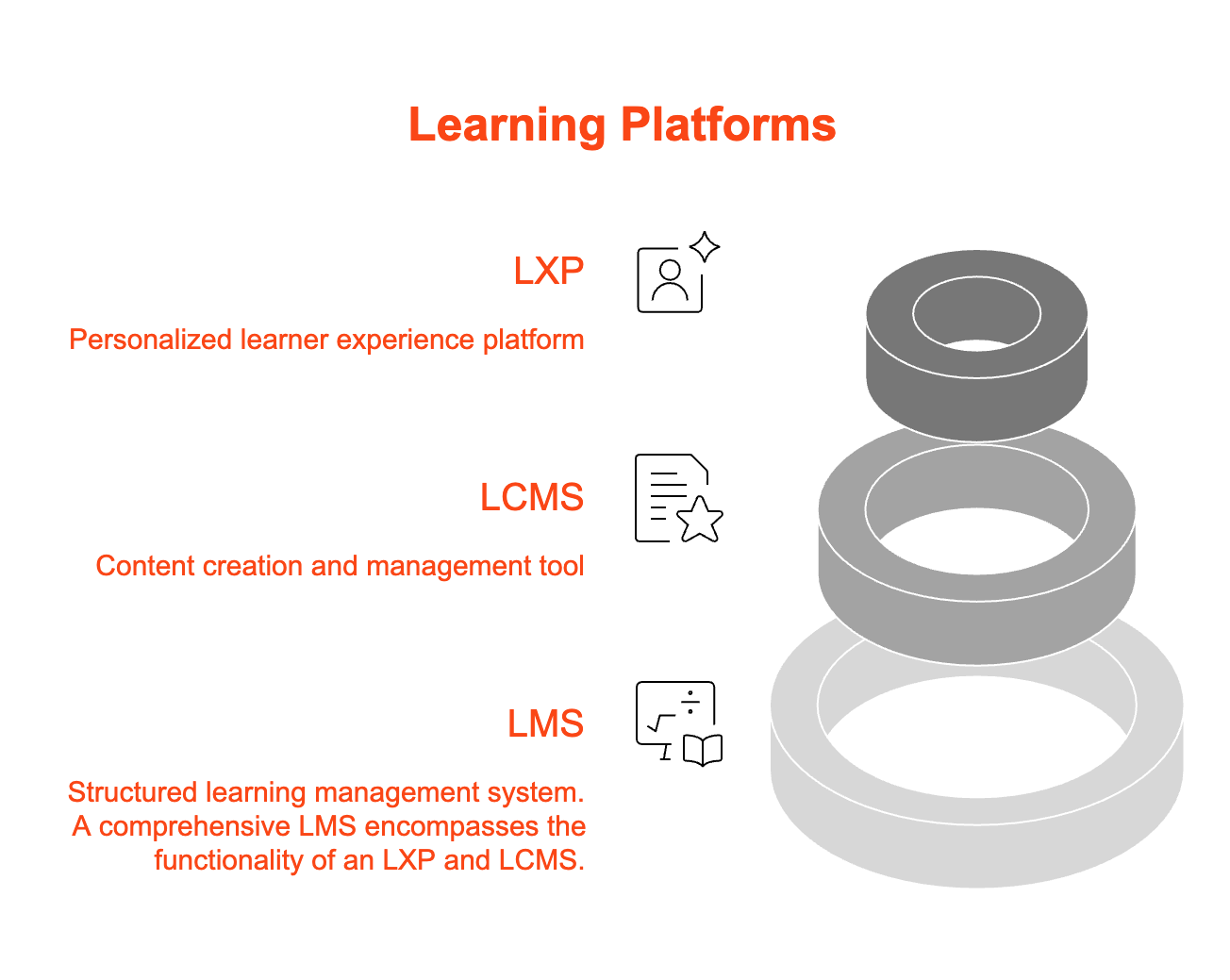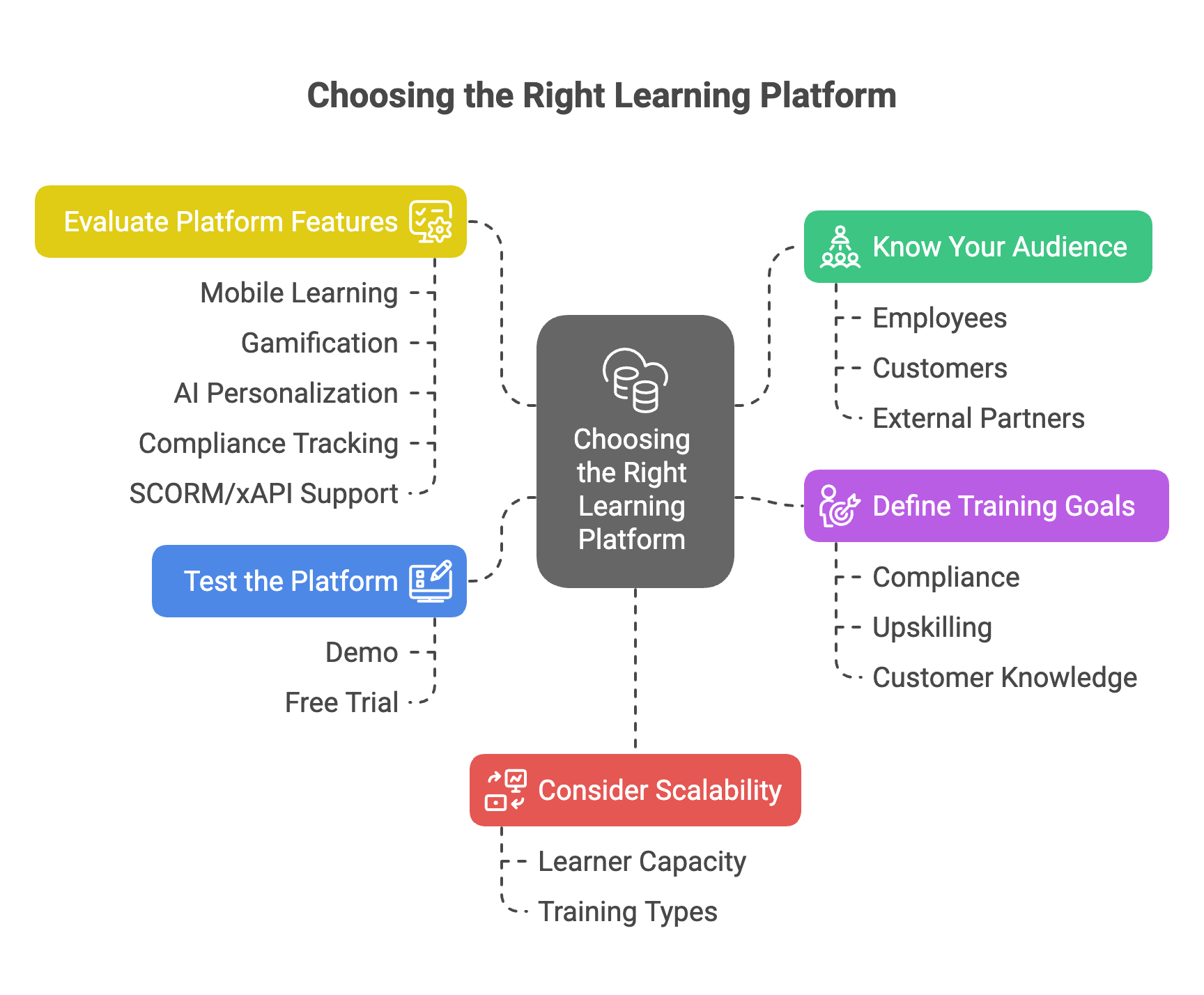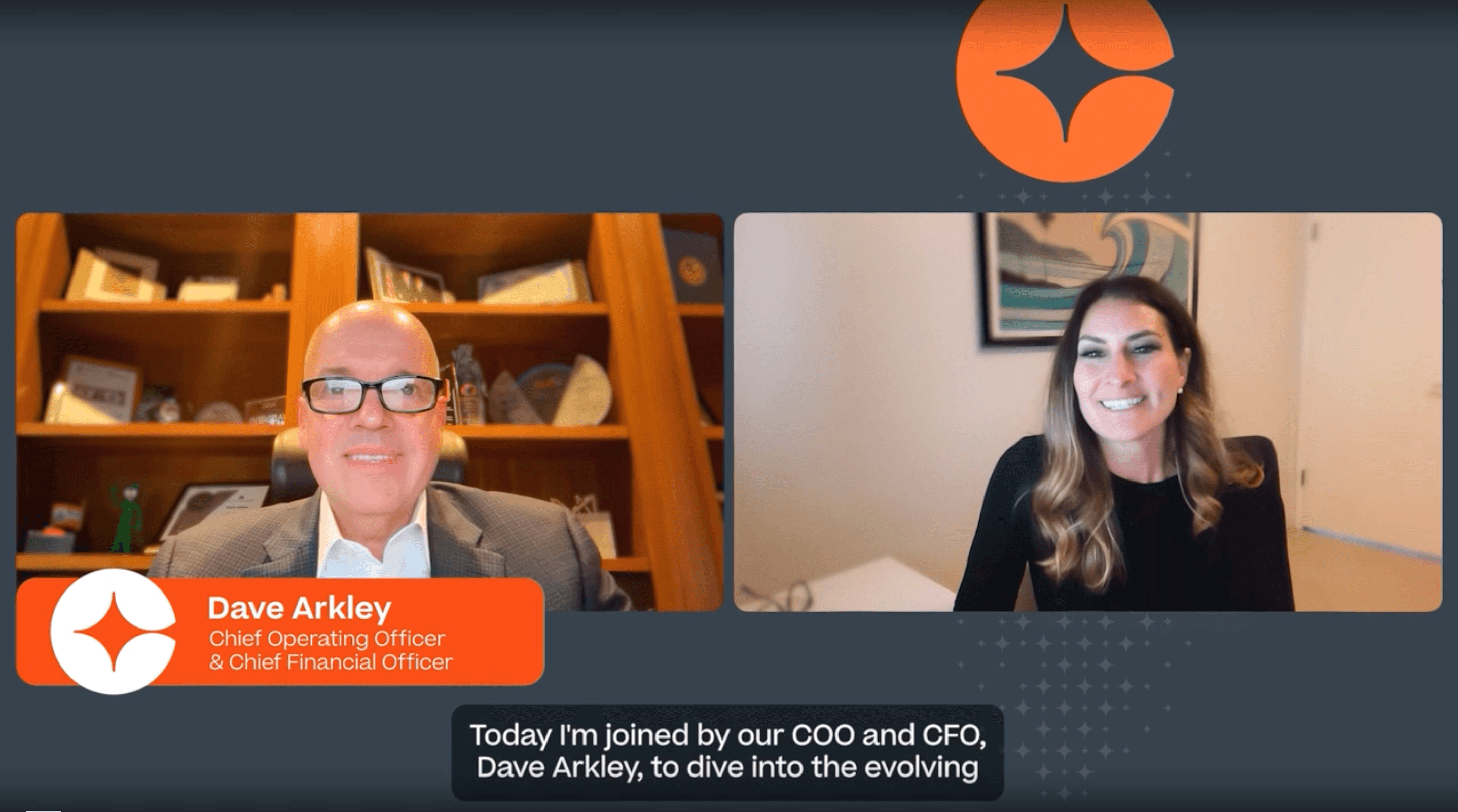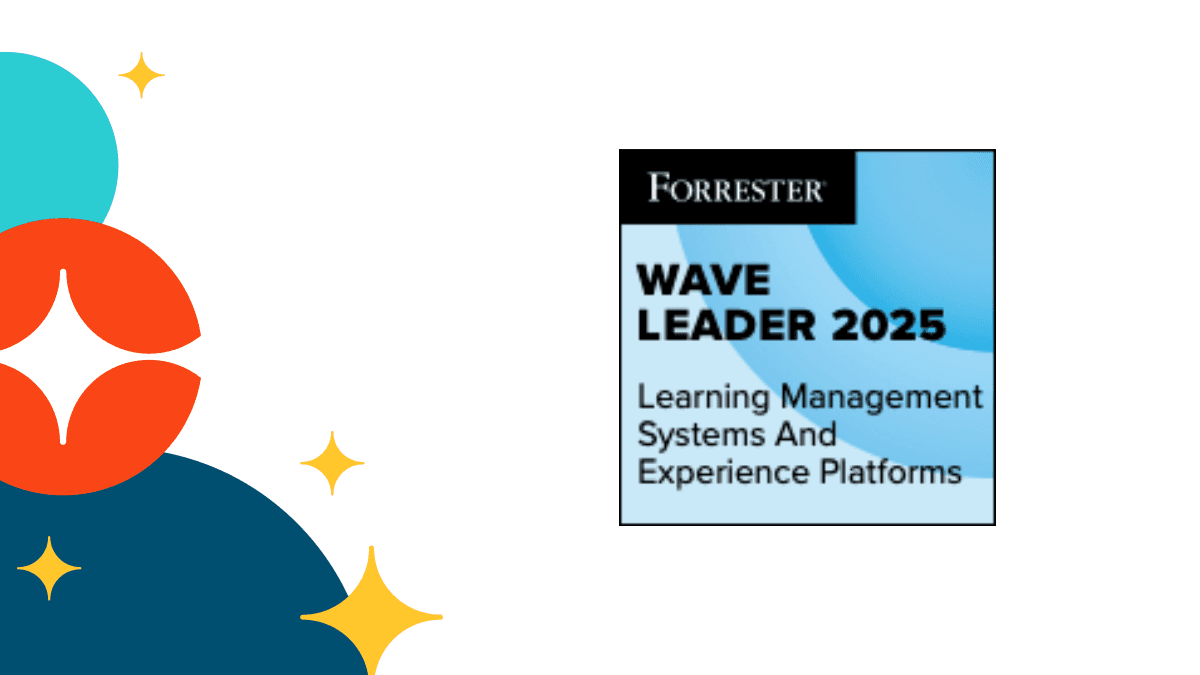Key Takeaways
- While there are different acronyms like LMS, LCMS, and LXP, it's best to find a tool that provides comprehensive features, as most LMSs encompass the functionalities offered by LXP and LCMS.
- Although we list different types of learning management system options, most LMS providers are only SaaS learning management systems, including Cornerstone.
- Must-have LMS features are course creation, tracking, compliance automation, catering to training needs in corporate, education, and compliance sectors.
Organizations and educational institutions need flexible and scalable solutions to manage learning and development. Learning Management Systems (LMS), Learning Content Management Systems (LCMS), and Learning Experience Platform (LXP) platforms are designed to address these needs by creating, managing, and optimizing learning experiences.
This guide explores the core concepts behind LMS, LCMS, and LXP, their key differences, and how Cornerstone's LMS integrates the best of all three systems. We’ll also dive into various industry-specific use cases, including education, corporate training, and compliance, along with the transformative power of AI-powered VR training.
What is a Learning Management System?

A learning management system is a software platform that organizations and educational institutions use to create, deliver, manage, and track educational content and training programs. Whether in corporate settings, educational institutions, or government sectors, LMS platforms streamline learning processes and enable effective remote and on-demand learning. LMSs first emerged in the 1990s and have seen growing usage during the COVID-19 pandemic due to the shift toward remote and hybrid learning and work.
Key Features of an LMS
- Course Creation and Management: Build interactive courses with multimedia elements, including video, quizzes, documents, and presentations.
- User Roles and Permissions: Manage roles for learners, instructors, and administrators with tailored access.
- Tracking and Reporting: Generate detailed reports on learner progress, completion rates, assessments, and engagement.
- Certification and Compliance: Automate the awarding of certificates and track mandatory training to ensure compliance with legal or industry standards.
What is an LMS Used For?
LMS platforms cater to a wide range of learning and training needs:
- Corporate Training: Train employees across multiple teams and locations, upskilling them to meet business objectives.
- Onboarding: Standardize onboarding processes for new hires by providing consistent training on company policies, culture, and job roles.
- Compliance Training: Automate regulatory training programs to ensure employees remain compliant with industry standards.
- Customer Training: Provide product or service training to customers, partners, and suppliers to improve adoption and satisfaction.
- Continuous Learning and Development: To boost engagement and retention, automatically assigning personalized continuous learning programs that are skills-driven. These learning programs can help align employees with the skills needed for career progression.
Cornerstone’s LMS offers robust tools to deliver all these learning use cases, tailored to fit various industries and audiences.
What are the Types of Learning Management Systems?
Cloud-Based vs. Self-Hosted LMS
A cloud-based LMS, sometimes called SaaS LMS, is hosted externally and accessed online, offering flexibility and scalability for organizations with distributed teams or remote learners. Advantages of a cloud-based LMS include routine functionality upgrades and relying on the vendor to provide the technical infrastructure. Self-hosted LMS solutions, on the other hand, are managed on-premises, providing greater control over customization and data security, but come with increased maintenance and upgrade overhead. Self-hosted LMSs are sometimes called installed or on-premise LMS. Organizations choose between these platforms based on their size, budget, and technical needs, ensuring the LMS aligns with their long-term goals.
Open Source vs. Proprietary LMS
An open-source LMS is free and offers customization freedom, allowing organizations to tailor features and interface design to specific needs. If you don’t want to start from scratch like with a self-hosted LMS, this is a good option. However, it requires technical expertise for setup and maintenance and typically lacks functionality or is difficult to scale. Proprietary LMS solutions, like Cornerstone’s, provide ready-to-use features, support, integrations and regular updates, which are advantageous for organizations prioritizing efficiency and user-friendly design, supporting extensive learning experiences, from compliance training to skill development.
Mobile and Blended Learning Options
LMS platforms increasingly support mobile learning, enabling learners to access courses on the go. Mobile compatibility allows students, teachers, and employees to learn at their own pace and convenience. Additionally, blended learning options, which combine online and in-person training, offer flexibility and accommodate diverse learning preferences. With mobile and blended options, an LMS can cater to various audiences, creating an inclusive, adaptive learning environment.
What is an LCMS?
A learning content management system offers the ability to create and manage your learning content.
LCMS vs LMS: The Differences
- LMS focuses on delivering and tracking learning content, ensuring that learners complete assigned tasks.
- LCMS focuses on creating and managing learning content, ensuring the availability of high-quality, up-to-date materials.
Cornerstone integrates LCMS features to allow organizations to efficiently create, deliver, and manage their entire learning ecosystem within one platform, offering a seamless workflow from content creation to learner engagement.
By integrating AI-powered VR training, Cornerstone’s LMS ensures learners are prepared for real-world challenges through interactive, immersive, and personalized training sessions.
What is an LXP?
An learning experience platform focuses on personalizing and optimizing the learner’s journey, providing an experience that adapts to each individual’s needs, preferences, and learning history. An LXP is powered by AI and data-driven insights, ensuring that learners receive relevant, engaging content tailored to their unique roles and learning preferences.
Key Features of an LXP
- Personalized Learning Paths: Tailor content delivery to each learner based on their previous interactions, progress, and goals.
- Data-Driven Insights: Use data and analytics to continuously optimize the learning experience.
- Multi-Content Integration: Seamlessly combine diverse types of learning content, such as microlearning, social learning, and self-paced modules, into one unified experience.
LMS vs LXP: Understanding the Differences
Both learning management systems and learning experience platforms offer digital learning solutions, but they have different approaches to learning delivery and management. Understanding these differences can help organizations choose the right platform for their needs.
LMS: Structured and Administrator-Led
An LMS prioritizes a structured, administrator-led learning environment, where instructors and administrators set the learning paths, assign courses, and monitor learner progress. LMS platforms are ideal for organizations that need to ensure compliance, structured learning, and specific training outcomes.
LXP: Learner-Centric and Autonomous
An LXP takes a more learner-centric approach, allowing learners to curate their own learning paths and access content based on their interests, needs, and preferences. LXPs tend to focus more on user-generated content and social learning, providing a more open-ended learning experience.
LMS vs LXP: Key Considerations
- Structured vs. Flexible: An LMS offers structured learning paths set by administrators, while an LXP allows learners to choose their own content.
- Compliance and Reporting: LMS platforms are better suited for industries requiring compliance tracking and detailed reporting, while LXPs are more focused on providing a diverse range of learning content.
- Content Generation: LXPs often rely on user-generated content, which can lead to variability in quality, whereas LMS platforms typically deliver vetted, expert-designed content. For more details, see LMS vs. LXP vs. TXP: A Complete Guide.
Why Cornerstone LMS Stands Out
Cornerstone’s LMS offers the best of both worlds by integrating personalized learning paths and AI-driven content recommendations, all while maintaining the structured learning environment needed for compliance and formal training programs. This ensures that organizations can provide personalized, engaging, and structured learning experiences that meet their business objectives. Cornerstone's platform also offers the functionality of an LMS, LXP and LCMS. Cornerstone is a truly comprehensive learning platform, so if you're looking for a tool offering everything, consider chatting with our team about our employee learning options.
Why are Learning Management Systems Important?
Role in Modern Education and Corporate Training
Learning Management Systems play a pivotal role in both educational institutions and corporate environments. For schools and universities, an LMS offers a structured platform where students and teachers can collaborate seamlessly, promoting a robust learning culture. In the corporate sphere, LMS platforms ensure that employees, regardless of location, receive consistent, high-quality training. By centralizing online learning and providing adaptive learning experiences, an LMS bridges knowledge gaps, supports teaching efforts, and cultivates a collaborative learning environment across industries.
Impact on Employee Development and Compliance
An LMS is essential for fostering continuous employee development and maintaining regulatory compliance. With the ability to deliver standardized training content, LMS platforms help organizations upskill employees efficiently and align with industry standards. This feature is particularly critical in regulated fields like healthcare and finance, where compliance training is non-negotiable. Through structured training content and reporting capabilities, LMS software empowers instructors and administrators to track compliance, thereby reducing risk and promoting a culture of lifelong learning among learners.
How Does an LMS Work?
Core Functionalities and User Roles
An LMS operates through core functionalities tailored to different user roles, including admins, instructors, and learners. Administrators manage the system setup, define user permissions, and oversee course assignments. Instructors leverage LMS tools to develop and organize courses, upload training content, and track student progress. Learners, meanwhile, access courses, complete assignments, and engage in collaborative learning activities. These features make LMS platforms versatile tools, and adaptable to diverse training needs within educational and corporate environments.
Typical User Journey: From Enrollment to Completion
The user journey within an LMS begins with enrollment, where learners are assigned specific courses based on their roles or goals. From there, they can access a variety of training content, such as videos, quizzes, and interactive modules, all designed to create immersive learning experiences. Upon completion, the LMS tracks performance metrics and generates certifications where applicable. This streamlined process ensures that learners, whether students or employees, stay engaged and benefit from structured, meaningful learning experiences.
How Cornerstone’s LMS Streamlines Learning Management
Cornerstone’s LMS simplifies learning management by integrating powerful tools for course creation, reporting, and personalization. With features like automated assignments and AI-driven content recommendations, Cornerstone enables instructors to tailor learning paths to individual needs, enhancing engagement and learner outcomes. This functionality empowers organizations to deliver impactful training efficiently, supporting both personal and professional development at scale.
What are the Benefits of an LMS?
Enhanced Accessibility and Flexibility for Learners
An LMS promotes accessibility, enabling learners to access training content anytime, anywhere and from any device. This flexibility is invaluable for remote employees, international teams, and students with varying schedules. By making learning resources readily available, an LMS supports self-paced and adaptive learning, accommodating diverse needs across different industries and organization sizes.
Cost Savings and Improved Efficiency
By centralizing all learning resources in one platform, an LMS reduces the need for physical materials and travel, cutting training costs significantly. It also improves efficiency by automating tasks like enrollment, progress tracking, and reporting. For organizations, this translates into substantial time and resource savings, allowing for greater focus on developing a strong learning culture.
Centralized Content Management
An LMS streamlines content management, providing a single repository for all training materials. This centralized approach benefits instructors and admins, who can easily organize, update, and distribute content across courses. It also ensures consistency, as learners and partners have access to the most up-to-date information, enhancing the overall quality of learning experiences.
Tracking and Reporting for Compliance
One of the standout features of an LMS is its ability to track learner progress and generate reports, which is critical for compliance purposes. Administrators can monitor completion rates, assess knowledge retention, and ensure that mandatory courses are completed within required timeframes. For industries that require regulatory adherence, these tracking capabilities are indispensable, helping organizations mitigate risk and maintain high standards of accountability.
Personalized learning experiences
LMSs can offer automated, personalized learning at scale, tailored to specific role requirements and skills that learners wish to improve in order to reach career goals. These automated learning paths not only save Learning and Development administrators time, but also improve employee engagement and retention through customized learning programs. With advanced LMSs using next-gen technology like Cornerstone Immerse, VR training experiences with job training role play can be personalized even further using an immersive AI learning companion.
Industry-Specific Use Cases for Cornerstone’s LMS
Different industries have unique training needs, and Cornerstone’s LMS caters to a wide range of sectors, providing customizable solutions that meet industry-specific challenges. Below are some key use cases across major industries:
Education & EdTech
In the education sector, especially with the growth of EdTech, LMS platforms have become essential for delivering quality education to students, both in-person and remotely. Cornerstone’s LMS supports:
- K-12 and Higher Education: Manage student learning journeys, assessments, and course materials. Teachers can assign self-paced modules or live lessons while tracking student engagement and progress.
- Online Learning and eLearning: Universities and educational institutions use Cornerstone’s LMS to deliver online courses to global audiences, supporting distance learning and providing flexible access to learning materials.
- Microlearning and Mobile Learning: Incorporate bite-sized learning for students or professionals to consume content on-the-go, with mobile learning options available.
With EdTech advancing rapidly, Cornerstone’s LMS for educational institutions can power by offering scalable, efficient, and engaging platforms for learners and educators alike.
Corporate Training
Corporate training is one of the most common use cases for an LMS, allowing companies to offer consistent and scalable training to their employees. Cornerstone’s LMS for enterprises enables:
- Upskilling and Reskilling: Offer employees access to skill-building courses that align with their career development goals and business needs.
- Compliance Training: Ensure employees complete necessary regulatory training with automated course assignments and tracking.
- Onboarding: Provide new hires with a structured onboarding experience, ensuring they understand company policies, culture, and job expectations from day one.
Healthcare
The healthcare industry requires stringent compliance training and continuous professional development. Cornerstone’s LMS for hospitals & medical training enables:
- Deliver compliance training (e.g., HIPAA, OSHA) and track certifications for employees.
- Provide continuing education and skills development, ensuring that healthcare workers stay current with the latest procedures and technology.
- Manage shift-based learning, allowing employees to engage with training content at their convenience without disrupting patient care.
Financial Services
In the financial sector, ensuring compliance with changing regulations is critical. Cornerstone’s LMS for financial services is designed to:
- Automate compliance training and certification tracking for financial institutions.
- Offer training on evolving financial ethics and standards.
- Provide opportunities for employees to upskill in soft skills like customer service, as well as technical financial skills.
Retail & Franchising
With a high employee turnover and often large, dispersed teams, retail organizations need a flexible and scalable training solution. Cornerstone’s Retail LMS helps:
- Train employees on product knowledge and customer service.
- Deliver standardized training programs and microlearning content across multiple locations to ensure brand consistency.
- Provide seasonal and onboarding training quickly and efficiently.
Manufacturing
Manufacturing companies rely on skilled employees to operate complex machinery and ensure safety. Cornerstone’s LMS for manufacturing supports:
- Safety and compliance training to ensure that employees follow best practices in equipment operation and workplace safety.
- Operational training to improve productivity and reduce downtime by offering accessible, role-specific training on the factory floor.
Consulting & Professional Services
Consulting firms use Cornerstone’s LMS to:
- Deliver client training programs on best practices, new technologies, or industry trends.
- Provide continuous training to employees on new methodologies and frameworks.
- Develop certification programs to showcase expertise to clients, improving service delivery and customer satisfaction.
Telecommunications
In the telecommunications sector, training needs to be delivered consistently across global teams. Cornerstone’s LMS supports:
- Delivering identical, scalable training programs to dispersed teams, ensuring consistency in service delivery and technical know-how.
- Mobile learning ensures employees can access training from anywhere, especially important for field service workers.
How Cornerstone’s AI-Powered VR Training Transforms Learning
A major innovation in Cornerstone’s platform is its AI-powered VR training, which offers immersive, real-world training scenarios. This feature is especially valuable for industries where hands-on experience is crucial, such as healthcare, sales, and customer service.
How AI-Powered VR Training Works
Learners participate in virtual reality role-playing scenarios that simulate real-life situations, such as customer interactions, medical procedures, or sales presentations. The system provides real-time AI-driven feedback, allowing learners to refine their skills through practice and repetition.
Benefits of VR Training
- Immersive Learning: Learners experience real-world situations in a controlled, risk-free environment, making learning more engaging and effective.
- Real-Time Feedback: AI monitors performance and provides actionable feedback, helping learners improve more quickly.
- Scalability: VR training can be rolled out across multiple teams and locations, ensuring that all learners receive the same high-quality, immersive experience, regardless of their location or schedule.
- Hands-On Practice: Industries like healthcare, sales, and customer service benefit from hands-on experience, and VR training provides this without the need for live, on-the-job training.
How to Choose the Right Learning Platform for Your Organization

When selecting a learning platform, it’s crucial to evaluate your organization’s specific needs, goals, and training requirements. Here’s a step-by-step guide to help you make the right choice:
1. Know Your Audience
Start by identifying who you’ll be training—whether it’s employees, customers, or external partners—and what type of training they need (e.g., compliance, product training, onboarding). This will help you determine whether you need an LMS or a more flexible platform like an LXP.
2. Define Your Training Goals
Clarify your learning objectives and the outcomes you want to achieve. Are you focused on improving compliance, upskilling employees, or enhancing customer knowledge? Different platforms excel in different areas, so having clear goals will guide your decision.
3. Evaluate Platform Features
Make a checklist of must-have features, such as:
- Mobile learning for employees on the go.
- Gamification to boost engagement.
- AI-powered personalization for tailored learning paths.
- Compliance tracking to meet regulatory requirements.
- SCORM and xAPI support for content integration.
Cornerstone’s LMS offers a comprehensive set of features that support everything from corporate training to compliance and extended enterprise learning, making it a versatile choice for organizations across industries.
4. Test the Platform
Before making a decision, take the time to test potential platforms. Request a demo or take advantage of a free trial to see how the platform works in practice. Pay attention to ease of use, customizability, and support options.
Cornerstone offers a detailed demo, allowing you to explore its features and how it can fit your organization’s needs.
5. Consider Scalability
As your organization grows, your training needs will evolve. Choose a platform that can scale with you, whether that means handling a larger number of learners or expanding to include new types of training. Cornerstone’s LMS is designed to scale, making it a future-proof solution for growing organizations.
Are you a small or mid-sized business looking for right learning platform for your organization? Check out our in-depth guide on finding the right learning solutions for SMBs.
Challenges and Considerations When Implementing an LMS
Implementing an LMS can present several challenges, including:
Adoption Resistance
Challenge: Employees or students may resist adopting new technologies, especially if they are unfamiliar with online learning platforms.
Solution: Cornerstone’s intuitive interface and guided onboarding help ease the transition, increasing adoption rates.
Integration with Existing Systems
Challenge: Organizations often struggle to integrate an LMS with current software or CMS platforms.
Solution: Cornerstone’s LMS is designed to integrate seamlessly with popular platforms, minimizing disruption.
Customization and Scalability Needs
Challenge: As companies grow, they require systems that adapt and scale
Solution: Cornerstone offers scalable, customizable options to support both immediate and long-term learning needs.
Resource Allocation
Challenge: Implementing an LMS requires time, budget, and training resources.
Solution: Cornerstone’s expert support team assists organizations throughout the setup process, ensuring minimal downtime and efficient resource use.
Real-Life Use Cases of Cornerstone’s LMS
Aflac: Empowering Agents with a Personalized Learning Experience
Aflac, a leading insurance provider, aimed to provide its sales agents with more efficient, flexible learning options that could fit seamlessly into their demanding schedules. Since adopting Cornerstone Learning Experience in 2021 alongside Cornerstone Saba, Aflac has enabled agents to access quick, targeted training modules that drive skill development without disrupting their work. As Aflac’s sales training and delivery consultant Matthew Cook noted, “Their main focus is being out in the field to sell, so they have limited time for training.” Cornerstone’s platform allows agents to access resources on their own schedule, making continuous learning more accessible.
Cornerstone’s personalized learning paths feature bite-sized video content that agents can view “at lunch” or in between client meetings, as Cook highlighted, allowing them to stay up-to-date on essential skills.
Furthermore, Cornerstone’s support during implementation helped Aflac fully leverage the platform. “It was like a master class in enabling our team to be successful with the tool,” said technology manager Luke Mansour, emphasizing the value of Cornerstone’s ongoing partnership.
With Cornerstone, Aflac’s training initiatives have expanded to include interactive features like “Perfect Your Pitch,” where agents can practice sales presentations, receive real-time feedback, and build confidence in essential sales techniques. This has proven invaluable, especially for new agents, as Mansour noted, “Effective communication…is critical.”
This effective training model has inspired broader initiatives, like Aflac’s National Onboarding program and the DSC Leadership Academy, both of which support ongoing professional growth across all levels of the organization.
For more details, read the full case study on how Cornerstone empowers Aflac’s agents with flexible, impactful learning solutions.
Roche: Simplifying Learning to Boost Engagement and Efficiency
Roche, a leading biotech company, partnered with Cornerstone to transform its complex, multi-platform learning system into a streamlined experience that employees actively seek out. The goal was to accelerate the “speed to competency” for employees in roles critical to patient care and innovation. With Cornerstone Learning and Compliance solutions, Roche now offers a centralized, user-friendly platform that simplifies both mandated and skill-based training.
Reflecting on the transformation, Roche’s technology and administration manager Cristy Mangin shared, “The work that we do matters… Everything that we build or produce or manufacture is making a difference in patients’ lives.” Cornerstone’s platform allows learners to move through training efficiently with checkpoints, fostering a sense of accomplishment and confidence.
Mangin highlighted the shift from mandated use to voluntary engagement: “Now, it’s more people reaching out and saying, ‘When can I do my custom journey?’” By providing personalized learning paths, Cornerstone has helped Roche cultivate a learning culture that encourages employees to explore and develop essential skills, ultimately strengthening the organization’s impact.
For more details, read the full case study on how Cornerstone supports Roche’s innovative approach to workforce development.
Why Choose Cornerstone’s LMS?
A Learning Management System is a powerful tool that enables organizations to create, deliver, and manage training programs efficiently. By integrating features from LCMS and LXM, Cornerstone’s cloud-based LMS offers a comprehensive platform that supports personalized learning experiences, AI-powered content recommendations, and immersive VR training. It caters to the unique needs of various industries, from education and EdTech to healthcare, corporate training, and compliance.
Whether you need to train employees, onboard new hires, or deliver product training to external partners, Cornerstone’s Learning Management System offers a scalable, engaging, and efficient solution that meets your learning and development needs.
Frequently Asked LMS Questions
What are the essential features every LMS should have?
Every LMS should include features that facilitate course creation and management, user tracking, and reporting. Additionally, an effective LMS should offer role-based permissions, ensuring that learners, instructors, and admins each have the right level of access. Key features like gamification, content compatibility (SCORM, xAPI), and mobile access enhance user engagement and make learning more accessible.
How does an LMS improve employee training?
An LMS enhances employee training by centralizing learning content, automating training delivery, and tracking learner progress. With an LMS, organizations can provide consistent, high-quality training across multiple locations, ensuring employees remain compliant and up-to-date. It also offers on-demand access, allowing employees to learn at their own pace, which can improve engagement and retention.
Can an LMS be used for remote learning?
Yes, an LMS is well-suited for remote learning, providing online access to courses, training materials, and assessments. Features like video conferencing integration, discussion forums, and mobile access support a seamless learning experience from any location. This flexibility makes LMS platforms ideal for organizations with remote or distributed teams.
How can an LMS help with compliance training?
An LMS simplifies compliance training by automating course assignments, tracking completions, and generating reports. It allows organizations to monitor who has completed mandatory training and provides certification upon completion. This tracking capability ensures that employees remain compliant with industry regulations and can help mitigate compliance-related risks.
What types of organizations benefit most from an LMS?
An LMS benefits organizations in various sectors, including corporate, healthcare, education, and retail. Companies that require consistent training across multiple locations, strict compliance, or skill development programs see the greatest value. Educational institutions also use LMS platforms to support online and blended learning, making it easier for students to access materials and engage with instructors.
Is an LMS scalable for growing organizations?
Yes, an LMS like Cornerstone’s is designed to scale with organizational growth. As your team expands, you can add more users, customize learning paths, and incorporate new training modules without disrupting the platform’s performance. Scalable LMS platforms ensure that you’re equipped to meet the training demands of an evolving workforce.
How can an LMS enhance learning engagement?
An LMS enhances engagement by offering interactive features like gamification, multimedia content, and discussion forums. Learners can earn badges, complete quizzes, and participate in collaborative learning activities, which make the learning experience more dynamic. Personalization options, such as AI-driven content recommendations, also help tailor learning to individual needs, keeping learners motivated.
How does an LMS integrate with other HR and business systems?
Advanced LMS platforms like Cornerstone’s integrate with Human Resource Information Systems (HRIS), Customer Relationship Management (CRM), and other enterprise tools. These integrations allow seamless data sharing, automated enrollment, and tracking across platforms, enhancing workflow efficiency.
What are some best practices for implementing an LMS?
When implementing an LMS, start with a clear training strategy, ensure strong user support, and provide training on the platform for admins and instructors. Regularly update content, encourage learner feedback, and track engagement to continuously improve the learning experience.
How can an LMS help create a learning culture within an organization?
An LMS can promote a learning culture by making professional development accessible to all employees, encouraging skill-building, and recognizing achievements through certifications or badges. When employees feel supported in their learning, it fosters a growth-oriented workplace.
What metrics should I track to evaluate LMS effectiveness?
For effective LMS evaluation, track metrics like course completion rates, learner engagement, assessment scores, and feedback. Additionally, compliance rates, certification achievements, and training ROI are valuable for assessing the impact of an LMS on business goals.
How does AI enhance learning experiences in an LMS?
AI within an LMS can personalize learning by analyzing data to recommend courses, tailor content to individual preferences, and provide real-time feedback. This adaptive learning approach keeps learners engaged and supports their unique learning paths.
Can an LMS support microlearning and just-in-time training?
Yes, many LMS platforms, including Cornerstone’s, support microlearning by delivering short, focused learning modules. These quick lessons are ideal for on-the-job training or when employees need immediate access to specific information.
What are the security considerations for an LMS?
Security is crucial in an LMS, especially when handling sensitive data. Look for an LMS with secure login, data encryption, and compliance with industry standards like GDPR or HIPAA for data protection. Ensuring platform security protects both the organization and the learners.
How can an LMS support global training for multinational organizations?
An advanced LMS offers multilingual support, localized content, and flexibility for different time zones, making it ideal for multinational organizations. Additionally, mobile access and online features ensure that employees worldwide can access consistent, high-quality training.


